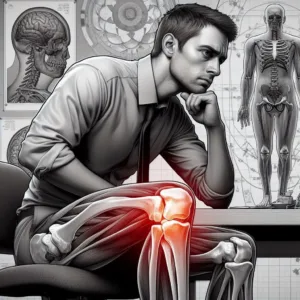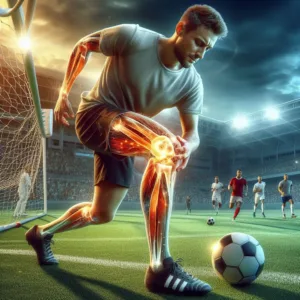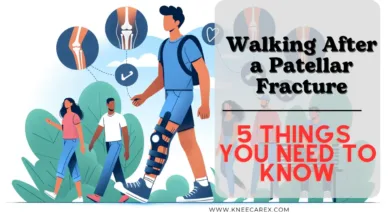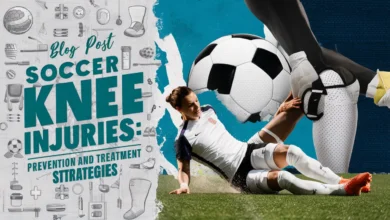Can I Play Football With Osgood Schlatter Disease | Best Strategies

As the adrenaline of football season kicks in, players of all ages are gearing up for game time. But for those dealing with Osgood Schlatter Disease, a common condition among young athletes, the question lingers: Can I Play Football With Osgood Schlatter Disease? Characterized by knee pain and inflammation at the top of the shinbone, Osgood Schlatter’s Disease can raise concerns about whether it’s safe to continue playing contact sports like football. In this article, we’ll dive into the world of Osgood Schlatter’s Disease and explore whether it’s possible to lace up those cleats and hit the gridiron without exacerbating this prevalent but manageable condition.
Osgood Schlatter disease patients should exercise caution and consult a healthcare professional before participating in football. Prioritize warm-up exercises, rest, and modifying training routines to prevent pain. Wear knee protection and minimize stress on affected areas. Seek personalized guidance from a medical expert to determine if football participation is feasible for you. Balancing health and love is crucial.
Osgood Schlatter Disease is an overuse injury affecting the growth plate in the shinbone during rapid growth spurts, particularly in running and jumping sports. It causes pain and swelling just below the knee, affecting agility and power. Despite its debilitating symptoms, there are ways to manage the condition effectively and potentially continue playing football without exacerbating symptoms or risking long-term damage. This condition can be managed effectively to ensure the safety and enjoyment of football for individuals with Osgood Schlatter Disease.
Contents
- 1 Understanding Osgood Schlatter Disease
- 2 Symptoms and Diagnosis of the Disease
- 3 Effects of Osgood Schlatter on Football Players
- 4 Risks of Playing Football with the Disease
- 5 Expert Opinions: Doctors and Physical Therapists Weigh In
- 6 Strategies for Managing Pain during Play
- 7 FAQ’s
- 8 Can I play football with Osgood Schlatter disease?
- 9 Conclusion: Play Football With Osgood Schlatter
Understanding Osgood Schlatter Disease

Acknowledging the nuanced nature of Osgood Schlatter Disease directs attention to the need for tailored approaches in managing one’s physical activities. Emphasizing low-impact exercises and techniques that alleviate pressure on the affected area can enable individuals to continue participating in athletic pursuits while mitigating discomfort. Furthermore, fostering an open dialogue with coaches and medical professionals contributes to a holistic support system that promotes physical health without compromising personal goals or long-term well-being. Ultimately, understanding this disease presents an opportunity for proactive self-care and informed decision-making—crucial elements in pursuing an active lifestyle despite its challenges.
Symptoms and Diagnosis of the Disease
The symptoms of Osgood-Schlatter disease can be quite frustrating for young athletes. Common signs include pain and swelling just below the knee, particularly during physical activity or after a period of rest. Some individuals may also experience tightness in the quadriceps muscles and tenderness around the tibial tubercle, making activities like running, jumping, or climbing stairs uncomfortable. It’s important to recognize that while these symptoms can be distressing, they are typically temporary and will often improve with time and appropriate management.
Diagnosing Osgood-Schlatter disease usually involves a thorough physical examination by a healthcare professional specializing in sports medicine or orthopedics. They may inquire about the individual’s medical history, assess their range of motion and muscle strength, as well as perform certain orthopedic tests to pinpoint the source of discomfort. In some cases, imaging studies such as X-rays or ultrasounds may be ordered to rule out other potential causes of knee pain and confirm the diagnosis. Understanding these symptoms and undergoing comprehensive diagnostic procedures can provide clarity for individuals dealing with Osgood-Schlatter disease as they navigate their participation in sports activities.
Best Radiologists for x-rays and ultrasounds near You
Effects of Osgood Schlatter on Football Players

In addition to physical discomfort, Osgood Schlatter disease may also affect a football player’s mental resilience. The frustration of being unable to perform at their best due to persistent pain and limitations imposed by the condition can take a toll on an athlete’s confidence and motivation. As such, it is crucial for coaches, parents, and players themselves to be aware of how Osgood Schlatter disease can impact not only physical abilities but also mental well-being. By understanding these effects and providing appropriate support, players with Osgood Schlatter can navigate their condition while still pursuing their passion for football.
Risks of Playing Football with the Disease
Playing football with Osgood Schlatter Disease poses significant risks to the affected individual. The nature of the sport, with its high impact and physical demands, can exacerbate the symptoms and lead to prolonged recovery. The repetitive running, jumping, and sudden changes in direction inherent in football can put added strain on the already inflamed area around the knee, leading to increased pain and potential structural damage. Moreover, engaging in contact sports like football while dealing with Osgood Schlatter Disease raises the risk of sustaining a more severe injury due to compromised stability and strength in the affected knee.
Furthermore, pushing through the discomfort of Osgood Schlatter Disease during football games or practices can impair proper rehabilitation and healing. Ignoring warning signs from your body may result in long-term consequences such as chronic pain or permanent damage that could impact not only athletic performance but also everyday activities. It’s essential for individuals with this condition to prioritize their health and consult with healthcare professionals before making decisions about playing football or engaging in other strenuous physical activities.
Expert Opinions: Doctors and Physical Therapists Weigh In

Furthermore, Dr. Sarah Patel underscored the significance of monitoring pain levels and advocating for timely rest periods during flare-ups. It is evident from these insights that a collaborative approach between doctors, physical therapists, and patients is crucial in making informed decisions about participating in high-impact sports like football with Osgood Schlatter Disease.
Strategies for Managing Pain during Play
When it comes to managing pain during play, it’s essential to prioritize injury prevention and proper self-care. One effective strategy is to incorporate a comprehensive warm-up routine before engaging in any physical activity. This can include dynamic stretching, foam rolling, and targeted exercises to strengthen the affected muscles and tendons. Additionally, utilizing protective gear such as knee braces or supportive taping can help stabilize the knee joint and alleviate discomfort during play.
Furthermore, embracing rest and recovery as an integral part of your training regimen is crucial for managing the pain associated with Osgood Schlatter disease. Incorporating regular rest days into your schedule allows the body to heal and repair itself, reducing inflammation and easing discomfort. Moreover, focusing on low-impact cross-training activities like swimming or cycling can provide a break from high-impact sports while maintaining cardiovascular fitness. Taking a holistic approach to pain management during play not only promotes physical well-being but also sets the foundation for long-term athletic success.
FAQ’s
Can I play football with Osgood Schlatter disease?
Osgood Schlatter disease patients should exercise caution and consult a healthcare professional before participating in football. Prioritize warm-up exercises, rest, and modifying training routines to prevent pain. Wear knee protection and minimize stress on affected areas. Seek personalized guidance from a medical expert to determine if football participation is feasible for you. Balancing health and love is crucial.
Can you run with Osgood-Schlatter?
Osgood-Schlatter disease affects athletes, but running can still be beneficial with proper management. Each case is unique, and seeking personalized guidance from a healthcare professional is essential. By understanding one’s body and limitations, athletes can develop strategies to manage their condition while continuing their passion for running.
What should I avoid doing with Osgood-Schlatter?
Osgood-Schlatter disease requires careful management, avoiding high-impact activities, sudden changes in intensity, deep knee bending or squatting, and proper warm-up and cool-down routines. These measures can help manage symptoms and reduce the risk of further complications, allowing individuals to better manage their condition and reduce the risk of further complications.
Knee Pain In Both Knees For Basketball Players: A Comprehensive Guide
Does Osgood-Schlatter affect athleticism?
Osgood-Schlatter disease can hinder athleticism for some athletes, but with proper management and care, they can continue excelling in their chosen sport. Working with healthcare teams to minimize pain and maximize performance is crucial. Overcoming challenges can foster mental toughness and resilience, and by committing to physical therapy, strength training, and flexibility exercises, athletes can continue their passion for sports.
Conclusion: Play Football With Osgood Schlatter
In conclusion, while individuals with Osgood Schlatter disease may face challenges when playing football, it is possible to manage the condition and continue participating in the sport with proper care and guidance. By incorporating targeted exercises, supportive equipment, and communication with healthcare professionals, players can minimize discomfort and reduce the risk of further injury. It’s important for those with Osgood Schlatter disease to listen to their bodies, take breaks when needed, and prioritize long-term health over short-term gains. Ultimately, with dedication and a proactive approach to managing the condition, individuals can still enjoy the physical and social benefits of playing football.




